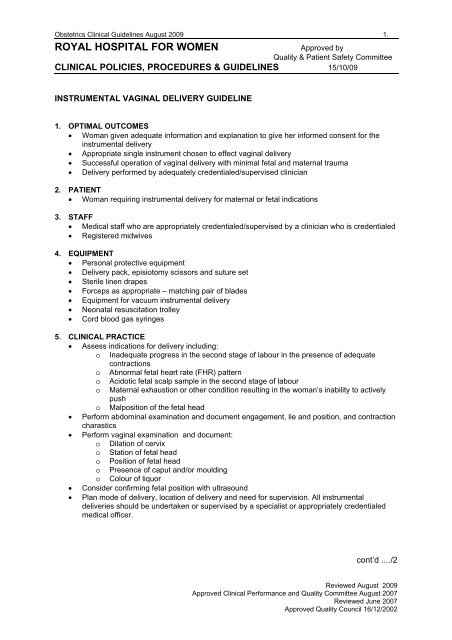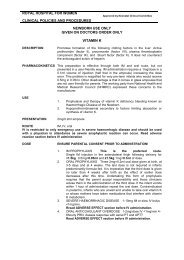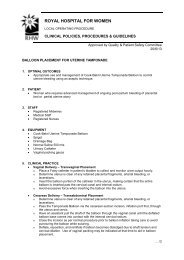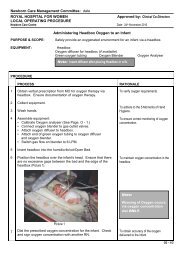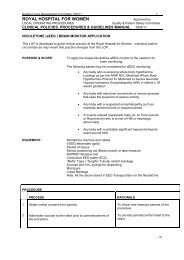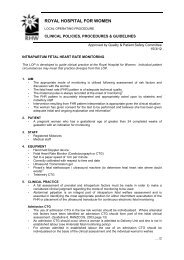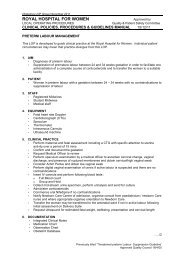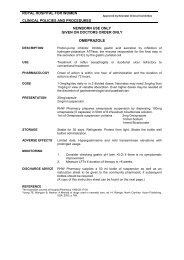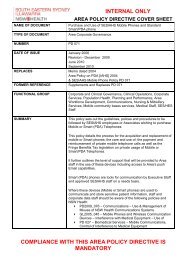Instrumental Vaginal Delivery Guideline
Instrumental Vaginal Delivery Guideline
Instrumental Vaginal Delivery Guideline
Create successful ePaper yourself
Turn your PDF publications into a flip-book with our unique Google optimized e-Paper software.
Obstetrics Clinical <strong>Guideline</strong>s August 2009 1.<br />
ROYAL HOSPITAL FOR WOMEN Approved by<br />
Quality & Patient Safety Committee<br />
CLINICAL POLICIES, PROCEDURES & GUIDELINES 15/10/09<br />
INSTRUMENTAL VAGINAL DELIVERY GUIDELINE<br />
1. OPTIMAL OUTCOMES<br />
• Woman given adequate information and explanation to give her informed consent for the<br />
instrumental delivery<br />
• Appropriate single instrument chosen to effect vaginal delivery<br />
• Successful operation of vaginal delivery with minimal fetal and maternal trauma<br />
• <strong>Delivery</strong> performed by adequately credentialed/supervised clinician<br />
2. PATIENT<br />
• Woman requiring instrumental delivery for maternal or fetal indications<br />
3. STAFF<br />
• Medical staff who are appropriately credentialed/supervised by a clinician who is credentialed<br />
• Registered midwives<br />
4. EQUIPMENT<br />
• Personal protective equipment<br />
• <strong>Delivery</strong> pack, episiotomy scissors and suture set<br />
• Sterile linen drapes<br />
• Forceps as appropriate – matching pair of blades<br />
• Equipment for vacuum instrumental delivery<br />
• Neonatal resuscitation trolley<br />
• Cord blood gas syringes<br />
5. CLINICAL PRACTICE<br />
• Assess indications for delivery including:<br />
o Inadequate progress in the second stage of labour in the presence of adequate<br />
contractions<br />
o Abnormal fetal heart rate (FHR) pattern<br />
o Acidotic fetal scalp sample in the second stage of labour<br />
o Maternal exhaustion or other condition resulting in the woman’s inability to actively<br />
push<br />
o Malposition of the fetal head<br />
• Perform abdominal examination and document engagement, lie and position, and contraction<br />
charastics<br />
• Perform vaginal examination and document:<br />
o Dilation of cervix<br />
o Station of fetal head<br />
o Position of fetal head<br />
o Presence of caput and/or moulding<br />
o Colour of liquor<br />
• Consider confirming fetal position with ultrasound<br />
• Plan mode of delivery, location of delivery and need for supervision. All instrumental<br />
deliveries should be undertaken or supervised by a specialist or appropriately credentialed<br />
medical officer.<br />
cont’d ..../2<br />
Reviewed August 2009<br />
Approved Clinical Performance and Quality Committee August 2007<br />
Reviewed June 2007<br />
Approved Quality Council 16/12/2002
Obstetrics Clinical <strong>Guideline</strong>s August 2009 2.<br />
ROYAL HOSPITAL FOR WOMEN Approved by<br />
Quality & Patient Safety Committee<br />
CLINICAL POLICIES, PROCEDURES & GUIDELINES 15/10/09<br />
INSTRUMENTAL VAGINAL DELIVERY GUIDELINE cont’d<br />
• Assess pre requisites for instrumental delivery:<br />
o Appropriate explanation and information must be provided to the woman and verbal<br />
consent obtained<br />
o Abdominal palpation. Fetal head must be engaged and contractions strong and<br />
frequent<br />
o Adequate analgesia where appropriate<br />
o Bladder empty<br />
o Cervix should be fully dilated and the membranes ruptured. An exception to this may<br />
be with a second twin<br />
o Determine the position and station of the fetal head<br />
o Elevate the woman’s legs – If lithotomy position is used the woman’s legs should be<br />
placed in the stirrups simultaneously.<br />
Vacuum assisted birth<br />
o Apply the vacuum cup to the flexion point. The flexion point is 3cm anterior to the<br />
posterior fontanelle in the mid line<br />
o Sweep a finger around the cup to ensure no maternal tissue is trapped beneath<br />
the cup<br />
o Increase pressure of the vacuum device to between 40 and 60 mms of Hg<br />
o Apply traction during contractions at right angles to the plane of the cup<br />
o Assess the need for episiotomy when fetal head distends the perineum.<br />
Episiotomy may not be required for vacuum delivery<br />
o Abandon the procedure:<br />
� When the cup is detached 3 times<br />
� When no bony descent has occurred over 3 consecutive contractions<br />
� When birth is not imminent within 15 minutes of the initial application<br />
of<br />
� the cup<br />
• Seek advice from senior medical staff when procedure needs to be abandoned<br />
• Document clinical events on instrumental birth record and in integrated clinical notes<br />
Forceps delivery<br />
o Lubricate the blades<br />
o Apply blades between contractions<br />
o Apply steady traction in the axis of the pelvis<br />
o Halt the traction in between contractions (except where immediate delivery is<br />
required)<br />
o Perform episiotomy as the fetal head distends the perineum. It is rare for<br />
episiotomy not to be required<br />
o Abandon the procedure:<br />
� when there has been no bony descent over 3 consecutive<br />
contractions or<br />
� when birth has not been achieved within 15 minutes of the initial<br />
application of the forceps<br />
• Seek advice from senior medical staff when procedure needs to be abandoned<br />
• Auscultate and record the fetal heart following every contraction during instrumental birth<br />
• Document clinical events on instrumental birth record and in integrated clinical notes<br />
cont’d ..../3<br />
Reviewed August 2009<br />
Approved Clinical Performance and Quality Committee August 2007<br />
Reviewed June 2007<br />
Approved Quality Council 16/12/2002
Obstetrics Clinical <strong>Guideline</strong>s August 2009 3.<br />
ROYAL HOSPITAL FOR WOMEN Approved by<br />
Quality & Patient Safety Committee<br />
CLINICAL POLICIES, PROCEDURES & GUIDELINES 15/10/09<br />
INSTRUMENTAL VAGINAL DELIVERY GUIDELINE cont’d<br />
6. HAZARDS/SUB-OPTIMAL OUTCOMES<br />
• No evidence-based indication for instrumental delivery<br />
• Inadequate pain relief<br />
• Medical officer inadequately skilled/supervised to undertake the instrumental delivery<br />
• Selection of incorrect forceps<br />
• Use of a forceps after vacuum<br />
• Episiotomy performed prior to abandoning procedure<br />
7. DOCUMENTATION<br />
• Integrated clinical notes<br />
• <strong>Instrumental</strong> birth record<br />
• Partogram<br />
• ObstetriX<br />
8. EDUCATIONAL NOTES<br />
• Compared to forceps the use of a vacuum extractor is associated with a higher risk of failure,<br />
more cephalohaematoma, sub-galeal haemorrhage and retinal haemorrhages but less use of<br />
regional anaesthesia and less maternal genital tract trauma.<br />
• Correct application of the vacuum cup:<br />
o promotes flexion of the fetal head when traction is being applied<br />
o allows the smallest diameter of the fetal head to present<br />
• Vacuum - Generally the Vacuum cup (soft and rigid cup) places less force to the fetal head,<br />
teaches the operator to follow the pelvic curve and requires less anaesthesia. Cup<br />
detachment may occur in 34% of cases for a variety of reasons.<br />
o Fetal injury increases significantly between 11 to 20 minutes duration as compared to<br />
less than 10 minutes<br />
• Classification of <strong>Instrumental</strong> <strong>Delivery</strong>:<br />
o Mid-cavity - The head is engaged but the leading edge of the skull is between the<br />
level of the spines and + 2cms from the spines<br />
o Low-cavity -- The leading edge of the fetal skull is at station ≥ + 2 cms. and not on<br />
the pelvic floor<br />
o Outlet forceps or Vacuum - The fetal scalp has reached the pelvic floor and is visible<br />
at the introitus without separating the labia<br />
o Rotational forceps – Keillands forceps<br />
o The use of an axis traction handle facilitates traction in the direction of the pelvic<br />
curve. Pajot's manoeuvre consists of applying traction in the same direction that the<br />
forceps handles extend, outward and away from the mother, whilst the other hand<br />
applies downward traction on the shanks of the forceps. These opposing forces will<br />
bring the head down under the symphysis pubis following the pelvic curve.<br />
• Caution should be used in attempting a Forceps birth after an unsuccessful Vacuum<br />
• Forceps can effect a more rapid delivery than the vacuum, this may be important when birth<br />
needs to occur quickly.<br />
• A variety of forceps are available for different clinical situations<br />
9. RELATED POLICIES/ PROCEDURES/CLINICAL PRACTICE GUIDELINES<br />
• Neonatal Resuscitation<br />
• <strong>Vaginal</strong> Examination<br />
• Second stage of labour<br />
• PPH<br />
• Obesity management in pregnancy<br />
• Accountable items in the birthing environment<br />
cont’d ..../4<br />
Reviewed August 2009<br />
Approved Clinical Performance and Quality Committee August 2007<br />
Reviewed June 2007<br />
Approved Quality Council 16/12/2002
Obstetrics Clinical <strong>Guideline</strong>s August 2009 4.<br />
ROYAL HOSPITAL FOR WOMEN Approved by<br />
Quality & Patient Safety Committee<br />
CLINICAL POLICIES, PROCEDURES & GUIDELINES 15/10/09<br />
INSTRUMENTAL VAGINAL DELIVERY GUIDELINE cont’d<br />
10. REFERENCES<br />
• Johanson RB, Menon BKV. Vacuum extraction vs forceps delivery. (Cochrane Review). In:<br />
the Cochrane Library, Issue 4 1999. Oxford Update Software.<br />
• Teng FY. Sayre JW. Vacuum extraction: does duration predict scalp injury? Obstetrics &<br />
Gynaecology. Feb, 1997;89(2):281-5.<br />
• Damos JR. Assisted vaginal delivery. Advanced Life Support in Obstetrics (ALSO) Course<br />
Syllabus, Chapter H, 4 th Ed. American Academy of Family Physicians, Kansas 2000.<br />
• Adapted from ACOG: Operative vaginal delivery. Practice Bulletin No 17, June 2000<br />
• Vacca A. Vacuum assisted delivery: An analysis of traction force and maternal and neonatal<br />
outcomes Australian & New Zealand Journal of Obstetrics & Gynaecology 2006; 46: 124-127<br />
• NSW Health Safety Notice 016/09 Safe <strong>Instrumental</strong> Birth, 28 July 2009<br />
…./attachment<br />
Reviewed August 2009<br />
Approved Clinical Performance and Quality Committee August 2007<br />
Reviewed June 2007<br />
Approved Quality Council 16/12/2002
MIDWIFERY RECORD OF INSTRUMENTAL BIRTH<br />
INDICATION:<br />
Delay in second stage<br />
Non-reassuring fetal heart rate trace<br />
Breech – after coming head<br />
Other<br />
ANALGESIA<br />
Analgesia/Anaestheti<br />
c<br />
Paediatrician Present<br />
Yes No<br />
• Epidural effective Yes No<br />
• Top up required – Time: hrs<br />
• Other Analgesia<br />
Place patient address label here<br />
Time notified _________hrs Time arrived ___________hrs<br />
VENTOUSE Time Ventouse Applied: ________ hrs Total mins of suction: _________<br />
1 ST Contraction<br />
2 nd Contraction<br />
3 rd Contraction<br />
Time Pressure Descent<br />
Yes/No<br />
Head Born @___________Baby born @ __________<br />
Pop off<br />
Yes/No<br />
Time<br />
reapplied<br />
Cord Blood Gases collected: No Yes Arterial ______________Venous_____________<br />
FORCEPS Forceps undertaken in <strong>Delivery</strong> suite Operating Theatres<br />
Decision to transfer to theatre: Time________Transfer to OT: Time ______________<br />
FHR<br />
Forceps Type: FHR<br />
1 st Blade applied @ Hrs 2 nd Blade applied @ Hrs<br />
1 st Contraction Visual Progress Yes No<br />
2 nd Contraction Visual Progress Yes No<br />
3 rd Contraction Visual Progress Yes No<br />
Forceps Type:<br />
1 st Blade applied @ Hrs 2 nd Blade applied @ Hrs<br />
1 st Contraction Visual Progress Yes No<br />
2 nd Contraction Visual Progress Yes No<br />
3 rd Contraction Visual Progress Yes No<br />
Forceps Successful Yes No Time decision made for LSCS ____________hrs<br />
Head Born @_______________Baby born @ __________ Apgars 1min ______5mins_______<br />
Cord Blood Gases collected: No Yes Arterial ______________Venous_____________<br />
SIGNATURE: PRINT NAME:<br />
Reviewed August 2009<br />
Approved Clinical Performance and Quality Committee August 2007<br />
Reviewed June 2007<br />
Approved Quality Council 16/12/2002


